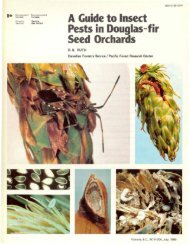Pacific Forestry Centre, Canadian Forest Service 506 West Burnside ...
Pacific Forestry Centre, Canadian Forest Service 506 West Burnside ...
Pacific Forestry Centre, Canadian Forest Service 506 West Burnside ...
Create successful ePaper yourself
Turn your PDF publications into a flip-book with our unique Google optimized e-Paper software.
t<br />
e<br />
t<br />
9;<br />
y<br />
s<br />
y<br />
xt<br />
to<br />
us<br />
be<br />
el<br />
or<br />
d<br />
sis<br />
ns<br />
ide<br />
md<br />
is<br />
)tal<br />
not<br />
;ses<br />
)celual<br />
owthe<br />
t to<br />
989;<br />
is of<br />
;eful<br />
:masdo<br />
olics<br />
gher<br />
:res.<br />
the<br />
)perurier<br />
dpal<br />
component analysis (Holmgren and Norden 1988;<br />
Holmgren et al. 1990; Chapman et al. 2001).<br />
However, the predictive ability of this method is<br />
generally limited to samples very similar to those<br />
in the classification set. Electron paramagnetic<br />
resonance spectroscopy has less diagnostic value,<br />
as it mainly shows a general tendency for free<br />
radicals to increase with decomposition (Holmgren<br />
et al. 1990; Karlstrom et al. 1994).<br />
Carbon-13 NMR of Peat<br />
A general problem with geochemical analysis<br />
techniques is that the yields of identifiable<br />
compounds cannot account for all of the C<br />
structures, even in fresh plant materials, and may<br />
decrease severely with increasing decomposition<br />
(Hedges et al. 2000). Carbon-13 (13C) NMR<br />
spectroscopy is a powerful technique that yields<br />
an overall characterization or fingerprint of the<br />
organic composition of complex substrates such<br />
as fresh plant material, litter inputs, organic<br />
matter (Preston 1996, 2001; Kogel-Knabner 2000),<br />
and peats and mucks (Preston and Ripmeester<br />
1982; Hammond et al. 1985; Preston et al. 1987;<br />
Norden and Albano 1989; Preston et al. 1989;<br />
Holmgren et al. 1990; Norden et al. 1992; Bergman<br />
et al. 2000). It is carried out on dry, powdered<br />
solids and thus can be used to examine intact<br />
samples or physical or chemical fractions. It uses<br />
high-speed spinning (magic-angle spinning or<br />
MAS), usually combined with cross-polarization<br />
(CP) from hydrogen nuclei to enhance sensitivity,<br />
the combined experiment being known as<br />
CPMAS NMR. There are definite limitations to its<br />
quantitative reliability, that is, its ability to detect<br />
all types of C with equal sensitivity. However, 20<br />
years on, these phenomena are well understood,<br />
and quantitative or semiquantitative spectra can<br />
be obtained under suitable experimental conditions,<br />
especially for samples high i:t:l<br />
.<br />
total C (Hu et<br />
al. 2000; Preston 2001).<br />
Figure 1 shows spectra of size fractions of two<br />
peats differing in degree of decomposition (from<br />
Preston et al. 1989). Spectra of Sphagnum and<br />
poorly decomposed peat typically have a large<br />
signal at 73 ppm from polysaccharides (C-2, C-3,<br />
and C-5), the major biochemical component. This<br />
is accompanied by the peak for anomeric C (C-1 of<br />
polysaccharides) at 105 ppm. The peak at 30 ppm<br />
comes from alkyl C, especially in long chains<br />
(-CH2-), and the carboxyl signal (173 ppm)<br />
includes contributions from free acids, amides,<br />
and esters. There is little intensity in the aromatic<br />
and phenolic regions (112-140 and 140-160 ppm,<br />
respectively).<br />
Changes in C Composition with Decomposition<br />
The changes due to decomposition (here<br />
reflected in decreasing particle size) are clearly<br />
shown by NMR. The accumulation of organic<br />
GATINEAU<br />
>2000 m<br />
Figure 1.<br />
FARNHAM<br />
>2000 m<br />
200 100 o ppm<br />
Carbon-13 cross-polarization magic-angle<br />
spinning nuclear magnetic resonance<br />
spectra of particle-size fractions of poorly<br />
decomposed Gatineau Sphagnum peat<br />
and well-decomposed Farnham peat with<br />
composition of 50% wood, 40% sedge,<br />
and 10% mosses. Reprinted from Organic<br />
Geochemistry, Volume 14, CM. Preston,<br />
D.E. Axelson, M. Levesque, S.P. Mathur, H.<br />
Dinel, and R.L. Dudley. Carbon-13 NMR<br />
and chemical characterization of particlesize<br />
separates of peats differing in degree<br />
of decomposition, pages 393-403, copyright<br />
1989, with permission from Elsevier<br />
Science.<br />
-X-383<br />
In! Rep. NOR-X-383<br />
31


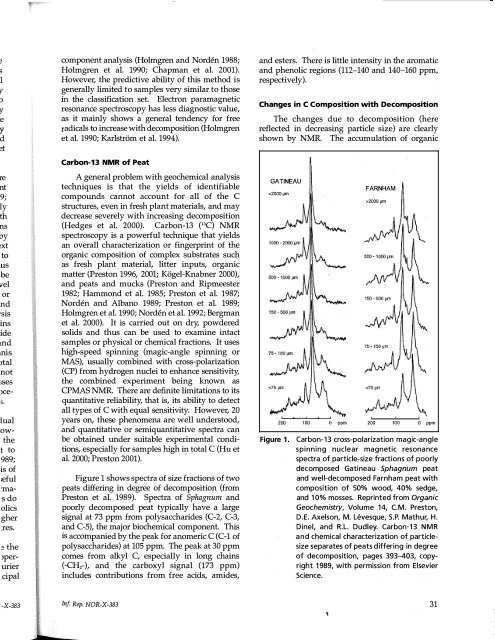
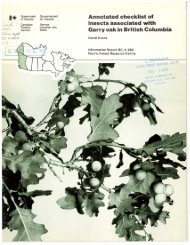
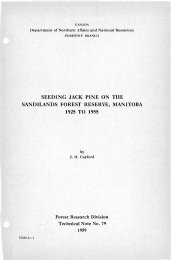
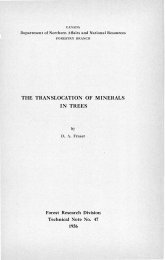


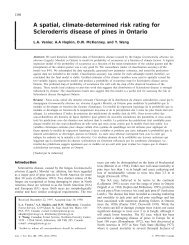

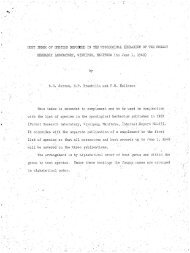
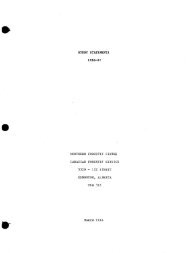
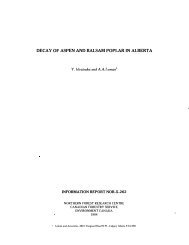
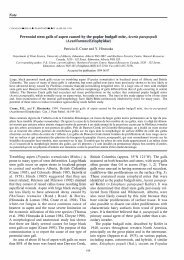
![Po],rell](https://img.yumpu.com/11946277/1/190x231/porell.jpg?quality=85)
